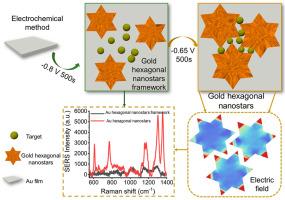Electrochemical synthesis of ultra-compact gold hexagonal nanostar substrate for enhanced and stable SERS detection
IF 6
2区 化学
Q1 CHEMISTRY, ANALYTICAL
引用次数: 0
Abstract
Background
Surface-enhanced Raman spectroscopy (SERS) amplifies Raman signals via localized fields on nanostructured metallic substrates. The fabrication of efficient substrates remains challenging, as nanolithography and templating are complex, while chemical reduction and self-assembly often suffer from low reproducibility and limited stability.Results
A rapid electrochemical deposition strategy is reported to synthesize gold hexagonal nanostar by precise modulation of particle size and spacing. The formation process is governed by a voltage-dependent balance between Au+ ion reduction kinetics and diffusion. Low overpotentials limit growth to small tip-localized features, while moderate potentials (–0.60 to –0.65 V) accelerate lateral expansion, increasing diameter and reducing spacing. At higher overpotentials (–0.70 to –0.75 V), diffusion-consumption imbalance drives vertical growth, widening spacing despite limited diameter gain. By programming deposition voltages and intervals, the gold hexagonal nanostars were tuned to an optimal diameter of 141.22 nm and an interparticle spacing of 14.72 nm. The resulting three-dimensional nanostructures generated abundant electromagnetic "hot spots," with a 44-fold SERS improvement over conventional counterparts. The substrates exhibited excellent signal uniformity with a relative standard deviation as low as 4.27%. The electrochemically active surface area via gold oxide stripping reaction, absorption rate and theoretical simulations were also computed.Significance
The engineered SERS substrate was successfully administered for direct ultrasensitive detection of malachite green and levofloxacin with high recovery rates in real fish and aquaculture samples. This template-free, programmable approach provides a scalable pathway for constructing high-performance SERS substrates, offering significant potential for applications in food safety monitoring and environmental analysis.

电化学合成超紧凑金六方纳米星衬底增强稳定的SERS检测
背景表面增强拉曼光谱(SERS)通过纳米结构金属衬底上的局部场放大拉曼信号。由于纳米光刻和模板技术非常复杂,而化学还原和自组装技术往往存在重复性低和稳定性有限的问题,因此高效衬底的制造仍然具有挑战性。结果采用快速电化学沉积的方法,通过精确调节颗粒大小和间距,合成了金六方纳米星。形成过程由Au+离子还原动力学和扩散之间的电压依赖平衡控制。低过电位限制生长到小的尖端局部特征,而中等电位(-0.60至-0.65 V)加速横向扩张,增加直径和缩小间距。在较高的过电位(-0.70至-0.75 V)下,扩散消耗不平衡驱动垂直生长,尽管直径增益有限,但间距扩大。通过编程沉积电压和沉积间隔,将六方金纳米星的最佳直径调整为141.22 nm,粒子间距为14.72 nm。由此产生的三维纳米结构产生了丰富的电磁“热点”,SERS比传统纳米结构提高了44倍。该衬底具有良好的信号均匀性,相对标准偏差低至4.27%。计算了氧化金汽提反应的电化学活性表面积、吸附速率和理论模拟结果。意义利用SERS底物对真实鱼类和水产养殖样品进行孔雀石绿和左氧氟沙星的直接超灵敏检测,回收率高。这种无模板、可编程的方法为构建高性能SERS基板提供了可扩展的途径,为食品安全监测和环境分析的应用提供了巨大的潜力。
本文章由计算机程序翻译,如有差异,请以英文原文为准。
求助全文
约1分钟内获得全文
求助全文
来源期刊

Analytica Chimica Acta
化学-分析化学
CiteScore
10.40
自引率
6.50%
发文量
1081
审稿时长
38 days
期刊介绍:
Analytica Chimica Acta has an open access mirror journal Analytica Chimica Acta: X, sharing the same aims and scope, editorial team, submission system and rigorous peer review.
Analytica Chimica Acta provides a forum for the rapid publication of original research, and critical, comprehensive reviews dealing with all aspects of fundamental and applied modern analytical chemistry. The journal welcomes the submission of research papers which report studies concerning the development of new and significant analytical methodologies. In determining the suitability of submitted articles for publication, particular scrutiny will be placed on the degree of novelty and impact of the research and the extent to which it adds to the existing body of knowledge in analytical chemistry.
 求助内容:
求助内容: 应助结果提醒方式:
应助结果提醒方式:


